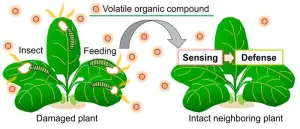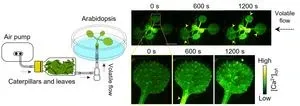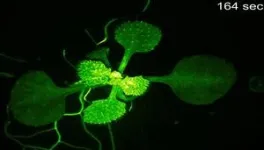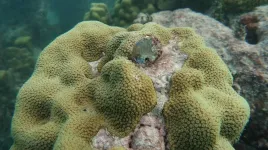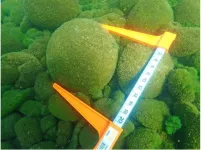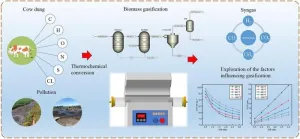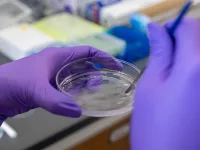(Press-News.org)
Saitama, Japan: Plants emit volatile organic compounds (VOCs) into the atmosphere upon mechanical damages or insect attacks. Undamaged neighboring plants sense the released VOCs as danger cues to activate defense responses against upcoming threats (Figure 1). This phenomenon of airborne communication among plants through VOCs was first documented in 1983 and has since been observed in more than 30 different plant species. However, the molecular mechanisms underlying VOC perception to defense induction remain unclear.
Unveiling the Invisible Conversation
The team, led by Professor Masatsugu Toyota (Saitama University, Japan), visualized plant-plant communications via VOCs in real time and revealed how VOCs are taken up by plants, initiating Ca2+-dependent defense responses against future threats.
This groundbreaking research will be published in Nature Communications on October 17, 2023. Yuri Aratani and Takuya Uemura led the work as a Ph.D. student and a postdoctoral researcher, respectively, in Toyota’s lab and collaborated with Professor Kenji Matsui at Yamaguchi University, Japan.
“We constructed equipment to pump VOCs emitted from plants fed by caterpillars onto undamaged neighboring plants and combined it with a wild-field, real-time fluorescent imaging system,” says Toyota. This innovative setup visualized bursts of fluorescence spreading in a mustard plant Arabidopsis thaliana after exposure to VOCs emitted from the insect-damaged plants (Figure 2; Video 1). The plants create fluorescent protein sensors for intracellular Ca2+ and therefore, changes in intracellular Ca2+ concentration can be monitored by observing changes in fluorescence.
“In addition to insect attacks, VOCs released from manually smashed leaves induced Ca2+ signals in undamaged neighboring plants,” says Toyota (Video 2).
To identify what type of VOCs induced Ca2+ signals in plants, Toyota’s team of scientists investigated various VOCs known to induce defense responses in plants. They found that two VOCs, (Z)-3-hexenal (Z-3-HAL) and (E)-2-hexenal (E-2-HAL), both six-carbon aldehydes, induce Ca2+ signals in Arabidopsis (Figure 3; Video 3). Z-3-HAL and E-2-HAL are airborne chemicals with grassy smells and are known as green leaf volatiles (GLVs) emitted from mechanically- and herbivore-damaged plants.
Exposing Arabidopsis to Z-3-HAL and E-2-HAL resulted in the upregulation of defense-related genes. To understand the relationship between the Ca2+ signals and the defense responses, they treated Arabidopsis with the Ca2+ channel inhibitor, LaCl3 and the Ca2+ chelating agent, EGTA. These chemicals suppressed both the Ca2+ signals and the induction of defense-related genes, providing evidence that Arabidopsis perceives GLVs and activates defense responses in a Ca2+-dependent manner.
Guard Cells: The Gateway to Awareness
They also identified which specific cells exhibited the Ca2+ signals in response to GLVs by engineering transgenic plants expressing the fluorescent protein sensors exclusively in guard, mesophyll, or epidermal cells. Upon Z-3-HAL exposure, Ca2+ signals were generated in guard cells within approximately 1 minute and then in mesophyll cells, whereas epidermal cells generated Ca2+ signals more slowly (Video 4). Guard cells are bean-shaped cells on plant surfaces and form stomata, small pores that connect inner tissues and the atmosphere.
“Plants do not possess a “nose”, but stomata serve as a plant gateway mediating rapid GLV entry into interspaces in leaf tissues,” says Toyota. In fact, they found that pretreating with abscisic acid (ABA), one of the phytohormones known for its ability to close stomata, reduced Ca2+ responses in wild-type leaves. On the other hand, mutants with impaired ABA-induced stomatal closures maintained normal Ca2+ signals in leaves even when treated with ABA.
“We have finally unveiled the intricate story of when, where, and how plants respond to airborne 'warning messages' from their threatened neighbors,” he says. “This ethereal communication network, hidden from our view, plays a pivotal role in safeguarding neighboring plants from imminent threats in a timely manner,” he adds.
This pioneering research not only deepens our appreciation for the astonishing world of plants but also underscores the remarkable ways in which nature has equipped them to thrive and adapt in the face of adversity. The profound implications of these findings resonate far beyond the boundaries of plant science, offering a glimpse into the intricate tapestry of life on Earth.
END
Researchers say mapping the genetic code of the brushtail possum will benefit those working to both conserve and control the animal.
In a five-year long study, just published in Nature Communications, an international group of researchers led by the University of Otago, has assembled the entire genetic code of the marsupial mammal.
The work also uncovered where and when their genes are expressed, and revealed surprising details about their population diversity, reproduction, and origins.
Study lead Associate Professor Tim Hore, of Otago’s Department of Anatomy, describes possums as “a fascinating animal that is loved ...
The factors affecting coral’s resilience — its ability to adapt to and survive environmental changes — seem to be more nuanced than scientists believed.
In a study published Oct. 18 in the journal Global Change Biology, researchers reveal surprising findings about a species common to Caribbean waters. The discovery may help improve efforts to save corals from bleaching and other consequences of climate change.
A team led by Assistant Professor of Biological Sciences Carly Kenkel at the USC Dornsife College of Letters, Arts and ...
We live in an era of data deluge. The data centers that are operated to store and process this flood of data use a lot of electricity, which has been called a major contributor to environmental pollution. To overcome this situation, polygonal computing systems with lower power consumption and higher computation speed are being researched, but they are not able to handle the huge demand for data processing because they operate with electrical signals, just like conventional binary computing systems.
The Korea Institute of Science ...
London, ON, October 17, 2023 – People experiencing homelessness accounted for an increasing proportion of fatal opioid-related deaths in Ontario, Canada, reaching one in six such deaths by 2021, according to new research from ICES, Western University and Lawson Health Research Institute.
In one of the first reports to track the continuous increase in opioid-related mortality in the province among people experiencing homelessness, researchers found that the quarterly proportion of opioid-related overdose ...
Over 4,800 years in the Northern Rockies during wet periods and dry periods, subalpine forests consistently recovered from wildfires, growing back vegetation and leaving evidence of their resilience in lake sediment cores.
Kyra Clark-Wolf, now a CU Boulder postdoc with the North Central Climate Adaptation Center (NC CASC), led the study as part of her dissertation research. NC CASC is a partnership of CU Boulder and the United States Geological Survey.
“I thought we might see different ecosystem responses to past fires between wet and dry periods,” said Clark-Wolf. “But ...
Rising lake water temperatures threaten the survival of marimo, unique algal balls found only in cold lakes. Kobe University researchers clarified that the warmer it gets, the more the inward decomposition outpaces the outward growth of these life forms, making them increasingly fragile.
Moss balls, or “marimo” in Japanese, are popular pet water plants that are not a moss but a special growth form of filamentous algae. They are found naturally in lakes in northern Japan and cold lakes of ...
The resource utilization of waste is an important means to implement the construction of ecological civilization. Agricultural waste contains rich renewable resources and has high potential value in fertilization and energy conversion. Anaerobic digestion technology is a promising technology for treating agricultural waste. Anaerobic digestion refers to the digestion technology in which organic matter is decomposed into CH4, CO2, H2O and H2S by facultative bacteria and anaerobic bacteria under anaerobic conditions, which can transform solid organic matter into soluble organic matter. Not only does it have the advantages of stable process and low operation cost, the biogas produced can also ...
UNIVERSITY PARK, Pa. — One double-helix strand of DNA could extend six feet, but it is so tightly coiled that it packs an entire sequence of nucleotides into the tiny nucleus of a cell. If that same DNA was instead split into two strands and divided into many, many short pieces, it would become trillions of uniquely folded 3D molecular structures, capable of bonding to and possibly manipulating specifically shaped molecules — if they’re the perfect fit.
These short, single-stranded segments of DNA or RNA are called aptamers, also known as “chemical antibodies.” According to Penn State researchers, ...
Many people who dream of an organized, uncluttered home à la Marie Kondo find it hard to decide what to keep and what to let go. But for those with hoarding disorder — a mental condition estimated to affect 2.5% of the U.S. population — the reluctance to let go can reach dangerous and debilitating levels.
Now, a pilot study by Stanford Medicine researchers suggests that a virtual reality therapy that allows those with hoarding disorder to rehearse relinquishing possessions in a simulation of their own home could help them declutter ...
A new study by Australian researchers has shown that fluctuating blood pressure can increase the risk of dementia and vascular problems in older people.
Short blood pressure (BP) fluctuations within 24 hours as well as over several days or weeks are linked with impaired cognition, say University of South Australia (UniSA) researchers who led the study.
Higher systolic BP variations (the top number that measures the pressure in arteries when a heart beats) are also linked with stiffening of the arteries, associated with heart disease.
The findings have been published in the journal Cerebral Circulation – Cognition and ...
